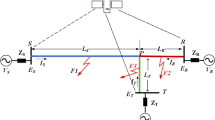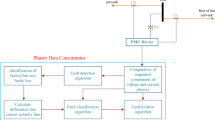Abstract
A precise and robust fault location method based on positive and negative sequence fault components for transmission lines is proposed, with synchro phasor data. This method utilizes the information of current and voltage synchronously measured by the phasor measurement units at both ends of the line, and does not require line parameters. The line parameters are not constant due to load and weather conditions and other factors, which affects the accuracy of most ranging algorithms relying on line parameters. For asymmetric faults, positive sequence and negative sequence fault components are used to locate the fault location, and for symmetric faults, positive sequence fault components are used to locate the fault location. The method is added to the synchronization data self-diagnosis procedure to further improve the accuracy of positioning. Then, the paper presents the method derivation and the simulation results by PSCAD/EMTDC under different path resistance, fault type, fault inception angle, load current, and line transposition, measurement error. The simulation results prove that the method efficiently and accurately determines the fault location.












Similar content being viewed by others
References
Zhen YX, Xu G, Li R (2010) A new fault-impedance algorithm for distance relaying on a transmission line. IEEE Trans Power Del 15(2):2328–2338
Magnago FH (1998) Fault location using wavelets. IEEE Trans Power Del 13(2):1475–1480
Girgis A, Hart D, Peterson W (1992) A new fault location technique for two- and three-terminal lines. IEEE Trans Power Del 7(3):98–107
Rui F, Liu Y, Diao RS, Wang SB (2018) Precise fault location on transmission lines using ensemble Kalman filter. IEEE Trans Power Del 33(4):3252–3256
Kang N, Chen JX (2017) A fault-location algorithm for series-compensated double-circuit transmission lines using the distributed parameter line model. IEEE Trans Power Del 32(3):2398–2407
Gopalakrishnan D, Hamai M, McKenna S (2000) Fault location using the distributed parameter transmission line model. IEEE Trans Power Del 15(8):1169–1174
Karcius M, Dantas KM, Silva KM, Flavio KM (2018) Accurate two-terminal transmission line fault location using traveling waves. IEEE Trans Power Del 33(3):873–880
Kezunovic M, Perunicic B (1988) Automated transmission line fault analysis using synchronized sampling at two ends. IEEE Trans Power Del 11(5):121–129
Dobakhshari AS, Ranjbar M (2015) A novel method for fault location of transmission lines by wide-area voltage measurements considering measurement errors. IEEE Trans Smart Grid 6(5):874–884
Dobakhshari A.S (2018) Wide-area fault location of transmission lines by hybrid synchronized/unsynchronized voltage measurements. IEEE Trans Smart Grid 9(3):186–192
Azizi S, Pasand SM (2014) Fault location on multiterminal DC systems using synchronized current measurements. Int J Electr Power Energy Syst 64:779–786
Preston G, Radojevic M, Kim H, Terzija V (2011) New settings-free fault location algorithm based on synchronized sampling. IET Gen Transm Distrib 5(2):376–383
Jiang JA, Lin YH, Liu CW, Ma JC (2000) An adaptive PMU based fault detection/location technique for transmission lines part I: theory and algorithms. IEEE Trans Power Del 15(3):486–493
Liao Y (2008) Fault location for single-circuit line based on bus-impedance matrix utilizing voltage measurements. IEEE Trans Power Del 23(5):609–617
Yu CS, Liu CW, Yu SL (2002) A new PMU-based fault location algorithm for series compensated lines. IEEE Trans Power Del 17(2):33–46
Liao Y, Elangovan S (2006) Unsynchronized two-terminal transmission line fault-location without using line parameters. IEE Proc Gener Transm Distrib 153:639–643
Feng G, Abur A (2016) Fault location using wide-area measurements and sparse estimation. IEEE Trans Power Syst 31(4):2938–2945
Zhao LH, Zhu JW, Gu B (2020) A new technique based on fundamental frequency positive sequence fault components for fault location. IEEJ Trans Electr Electron Eng 15:536–543
Zhang Y, Liang J, Yun Z, Dong XM (2018) A new fault-location algorithm for series-compensated double-circuit transmission lines based on the distributed parameter model. IEEE Trans Power Del 33(2):3249–3251
Liao Y (2008) Transmission line fault location algorithms without requiring line parameters. Electr Power Compon Syst 11(11):1218–1225
Niazy I, Sadeh J (2013) A new single ended fault location algorithm for combined transmission line considering fault clearing transients without using line parameters. Int J Electr Power Energy Syst 44:816–823
Davoudi M, Sadeh J, Kamyab E (2015) Parameter-free fault location for transmission lines based on optimisation. IET Gener Transm Distrib 9(11):1061–1068
Padmanabhan S, Terzija V (2013) Line parameter-free fault location algorithm for series compensated transmission lines. IEEE Power & Energy Society General Meeting, Vancouver, BC, pp 1–5
Lopes FV, Dantas KM, Silva KM, Costa FB (2018) Accurate two-terminal transmission line fault location using traveling waves. IEEE Trans Power Deliv 33(2):873–880
Elsadd MA, Abdelaziz AY (2018) Unsynchronized fault-location technique for two- and three-terminal transmission lines. Electr Power Syst Res 158:228–239
Davoudi M, Sadeh J, Kamyab E (2018) Transient-based fault location on three-terminal and tapped transmission lines not requiring line parameters. IEEE Trans Power Deliv 33(1):179–188
Sardari H, Mozafari B, Shayanfar HA (2020) Fast & adaptive fault location technique for three-terminal lines. Electr Power Syst Res 179:106–184
IEEE Guide for Determining Fault Location on AC Transmission and Distribution Lines, IEEE Standard C37.114TM-2004 (2005)
Acknowledgements
This work was supported in part by the National Natural Science Foundation of China under Grants 51777024, 61806126.
Author information
Authors and Affiliations
Corresponding author
Additional information
Publisher's Note
Springer Nature remains neutral with regard to jurisdictional claims in published maps and institutional affiliations.
Hongzhe Yang have contributed equally to this work.
Rights and permissions
About this article
Cite this article
Zhao, L., Zhu, J. & Yang, H. A Precise Fault Location Method Independent of Line Parameters Based on Positive and Negative Sequence Fault Components. J. Electr. Eng. Technol. 17, 3133–3143 (2022). https://doi.org/10.1007/s42835-022-01126-y
Received:
Revised:
Accepted:
Published:
Issue Date:
DOI: https://doi.org/10.1007/s42835-022-01126-y




